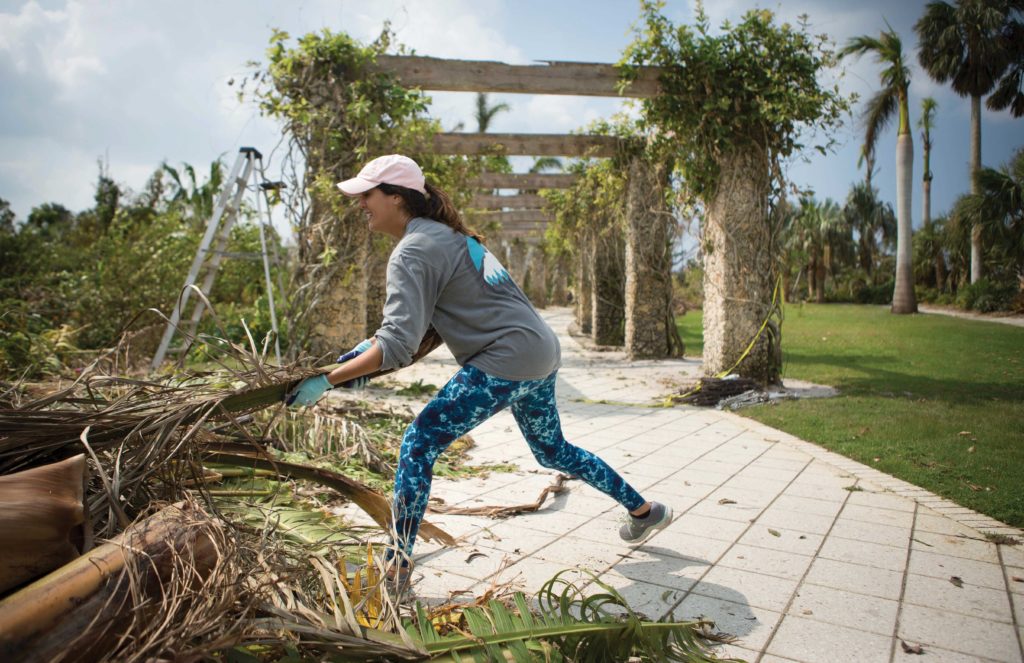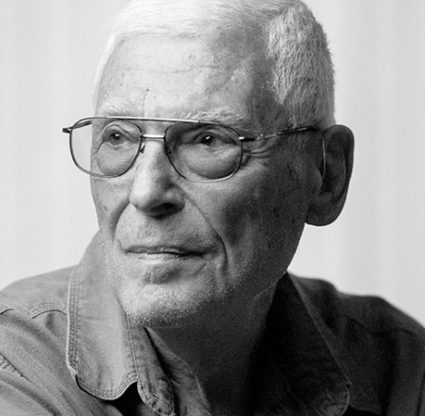Want an analogy for Southwest Florida, post-hurricane? Here it is: It’s a Sunday morning, Oct. 1, three weeks to the day since Hurricane Irma roared through, and the parking lot of Naples Botanical Garden is teeming with traffic. Inside, flowers are blooming (never mind that they were planted just two days before); children are splashing in a fountain (which mercifully proved operational); and a long-planned sculpture exhibit arrived on time and just in time to distract from the storm’s scars. If visitors, some 1,900 that day, were attentive enough, they might have noticed tender new leaves sprouting on branches.
Some of Southwest Florida’s best-loved and most defining places suffered a bruising when Irma made landfall on Sept. 10. By Sept. 11, staff members and volunteers had armed themselves with chainsaws, wheelbarrows and shovels to dig out and rebuild.
They had no time to waste. Season was fast approaching, and with it, the billions in potential revenue for their organizations as well as for Lee and Collier counties. Lee County sees some 5 million people a year, who spend an estimated $3 billion—most of it during season. Collier welcomed 1.8 million visitors in 2016 and enjoyed $1.3 billion in direct spending. These guests are drawn to places like Naples Botanical Garden, the Naples Zoo at Caribbean Garden, Corkscrew Swamp Sanctuary, the Edison & Ford Winter Estates, the Everglades Wonder Gardens, the beaches.
Lucky for visitors (and homeowners, too), it’ll take more than 140 mph gusts to knock the wind out of Southwest Florida.
Here’s a look at how some of the region’s iconic spots fared during the storm, their push to reopen and the long-term journey some will take to fully recover—or to redefine themselves post-Irma.
Naples Botanical Garden
“Delirious.”
That’s how Chad Washburn, the garden’s deputy director, described himself and his colleagues at that Sunday morning reopening.
 |
|
Amid the wreckage, the garden's famed mosaic remains unscathed. |
In spite of his exhaustion, he was grinning, and so were President and CEO Donna McGinnis and Business Development Director Kara Laufer, and die-hard volunteers Judy Bergauer and Pat Ladrigan, and pretty much everybody else on-site.
Preparing for that day had been a whirlwind of labor, led by the 80-member staff with some 100 volunteers and horticultural experts from a half-dozen gardens. “We saw pictures of the damage,” Jim McDonnell of the Chicago Botanical Garden said on day three of his five-day stint. “It’s too much for just a small crew of people to do.”
For the staff, the first days had been utterly disorienting—there were vistas where there had once been trees, sun where there had been shade, scorched yellow where there had been lush green. “We’re going to lose a huge amount of plant material,” McGinnis said. Ten days out, they had collected 2 acres worth of debris, 6 feet deep. They expected to fill another 2 acres.
The horticultural team was fighting to save the plants they could, with preference to rare species or those with stories to tell, like the collection of the late Elsie Page of Naples. Among the wounded was her “monkey tree,” grown from a seed that Page had acquired from a renowned plant collector. It had bloomed magnificently—and for the first time—the year after her death.
The stories behind the plants—and the story behind the garden itself, its land cleared and cultivated by both staffers and residents—galvanized crews during long days in the hot sun.
“It’s a calming place, a place where people can come to restore themselves,” said Bergauer, who helped with the cleanup. “I think we want that back.”
On opening day, McGinnis described the garden as “tidy.” Now, she says, the staff will restore it to “impeccable,” a journey that will take them on a hunt for plants from around the world to replace what was lost. “I would say by the time high season comes, it will look nice,” McGinnis said. “The average visitor who hasn’t been here before will still think it’s a beautiful place. But we know what it was, and we’ll be building back to that.”
Naples Zoo at Caribbean Garden
Ten days post-Irma, the Naples Zoo is noisy—and it is not from the animal residents and human visitors, but instead from chainsaws and trucks and backhoes.
Jack Mulvena, the president and CEO, surveys the work.
 |
|
Rachel Forbes is the zoo's educational programs manager, but traded in her usual duties for cleanup work. |
“If you had asked me on that Monday morning when I thought we were going to open, I think I would have said months and months,” he says. He arrived there at 6:45 the morning after to find trees downed, pathways inaccessible, fences wrecked, Lake Victoria overflowing. Two animals, antelope species, perished.
“It was overwhelming,” he remembers. “It’s a former botanical garden, so unlike a lot of zoos, the property is chock-full of historic trees. Some date back to 100 years.”
Some of those trees withstood the winds; others, including two nearly century-old ones planted by its founder, came down. The cost to remove them promised to be steep, an estimated $100,000 to $150,000 for professional arborists and another $100,000 in additional site work. Donations had already started pouring in.
But all was not as disastrous as that first morning made it appear. The remaining animals were safe; the smaller species had been crated and evacuated to the home of Nancy Jane Tetzlaff, who had founded Jungle Larry’s Caribbean Gardens, the zoo’s predecessor, along with her late husband. The glass enclosures were intact; the gift shop and the two trailers used for staff offices were standing; and the old toucan sign, dating back to the 1950s, survived Irma—just as it had Donna, Andrew, Charley and Wilma.
“Being able to get ready and open will be good for the zoo and good for the community,” says Mulvena, who leads a staff of about 80.
The zoo welcomed back guests on Oct. 14. A $25 million capital campaign and enhancement plan is pushing ahead.
Edison & Ford Winter Estates
No, it is not the banyan. And no, Thomas Edison did not plant it.
Chris Pendleton, president and CEO of the Edison & Ford Winter Estates, no doubt would have liked to have audio-recorded that statement and then played it back every time someone gasped at the uprooted tree in the inventor’s front yard or called her in dismay after hearing early (and incorrect) reports that the beloved banyan had fallen.
 |
|
CEO Chris Pendleton stands by the roots of a giant mysore fig. |
The specimen in question is impressive—an overturned mysore fig with roots as tall as a house. “It was not an original Edison tree,” says Pendleton, offering an old photo of Edison’s landscaping, two lines of mango trees, as evidence. The city planted the fig in the 1950s or ’60s after Mina Edison deeded the property for municipal use.
The estates lost about 150 trees and shrubs, Pendleton says, including 14 that were historic to the Edison/Ford era. The staff will replace most of the latter with so-called “sister trees” to maintain historical accuracy. What the estates didn’t lose: the houses or the lab or Mina’s serene Moonlight Garden or the new pavilion (built, ironically, with FEMA money from a previous storm) or the coconut grove where a wedding would take place just two weeks after the storm.
Pendleton says she’s using Irma’s pruning to her advantage. “This gives us more of an opportunity to restore our original landscape,” she says. Pendleton says she and her team have been slowly transforming the grounds back to its founder’s design.
The Estates are reopening in phases, starting with the relatively unscathed eastside with the lab, museum and the perfectly fine banyan. Events, including a much-anticipated Smithsonian Spark!Lab exhibit, are going on as scheduled. And, yes, that includes Holiday Nights, that long-running tradition beloved by locals and a tremendous holiday draw for visitors.
“By November, we’ll be fully operational,” Pendleton promises. (Editor's Note: The Estates opens Nov. 3.)
Related: Readers share their hurricane stories
Corkscrew Swamp Sanctuary
Along the boardwalk at Audubon Corkscrew Swamp Sanctuary lie clumps of bromeliads. Staff members and volunteers are carefully plucking these tree-dwelling plants from fallen trunks and fractured branches in order to reintroduce them to new hosts. They’re doing the same with orchids—but not the famous “super ghost.” That specimen fared just fine in its 50-foot-high perch in an old-growth bald cypress.
Such is the care that goes into the keeping of this ancient forest.
 |
|
Crews clear trees from the sanctuary's boardwalk. |
“It’s been inspiring, really,” says Sally Stein, the director of public programs, of the massive cleanup effort by staff and volunteers, assisted by Signature Tree Service, which is donating its services.
It’s 17 days post-storm, and parts of the boardwalk remain impassable. The staff and volunteers are concentrating on clearing a 1-mile stretch that they would open on Oct. 6 and would then continue clearing the remaining 1.25 miles.
Stein climbs over downed trunks blocking the path to the “legacy trees.” These are 12 old-growth bald cypress trees named in honor of famed conservationists and naturalists. Irma claimed two, DaVinci and Guy Bradley, each estimated to be 400 years old. She also took another visitor favorite, the Bee Tree, named for the honeybee hive found in a hollowed nook.
“It’s sad because so many of my favorite trees fell down. You come to love them, and then you see them down,” Stein says. “But they’ll become habitat for something else. It could have been much worse.”
Irma provided a new chapter for Corkscrew’s story. Guides can talk about how wildlife will find new uses for storm-toppled trees. They can point out the buds forming on cypress branches during what is typically the dormant season. And, critically, they can talk about the role Corkscrew and other wetlands played in this storm, and every major storm, collecting and absorbing water that otherwise would gush into already deluged developments.
“Our infrastructure is just overwhelmed,” Jason Lauritsen, the sanctuary director, says of the flooded communities in Lee and Collier. He’d like to use Irma as a teaching moment—a visual reminder of the role wetlands play in mitigating the impact of these weather events, and a compelling argument for wetlands preservation.
“I’m going to be telling this story to our boardwalk volunteers and our visitors and to our public officials,” Lauritsen says. “We have the responsibility to make those connections.”
Everglades Wonder Gardens
Just when the fate of the gardens seems to have been settled, wham! In comes Irma. The gardens had changed hands two years ago from the Piper family, which founded it as a roadside attraction back in the 1930s, to a nonprofit established to protect it from development when the family was ready to sell. The board earlier this year had hired a new executive director with deep experience in environmental and botanical nonprofits.
 |
|
Irma made a mess at the wonder gardens but may have jumpstarted plans to re-do the property. |
Now, that director, Thomas Hecker, is standing in the midst of a mess.
“Before in here it was all shade, like a rainforest,” says Hecker, surveying the tattered, sun-dappled grounds. The gardens lost some 50 trees, including a rare, two-headed sabal palm, and some 80 percent of its canopy. Amber Piper, the operations manager who married into the founding family, likened it to the movie Jumanji following the animal stampede.
“I saw it after Charley. I saw it after Wilma. But (the damage) has never been to this extent,” Piper says.
Hecker, nevertheless, did not have to stretch to find his silver lining. The new director had wanted to take the attraction in a new direction, and the wind started the redesign for him.
“I was worried about cutting down trees. I don’t have to worry about that anymore,” Hecker quipped. Among his plans is the installation of four donated atrium solariums, handmade in Paris. “As a roadside attraction, it was quirky and it worked, but now I want to take it in the direction of a respected nonprofit, a part of the botanical garden world.” (Editor's Note: The wonder gardens reopens Nov. 4)
Related: One-On-One with Director of Collier County Bureau of Emergency Services Dan Summers
But let’s not forget…
The organizations above are among the most visible of our attractions, but they were not the only ones wounded in the storm. Small mom-and-pop operations—just as essential to the local economy, the visitor experience and the lives of the locals—are struggling to rebuild, too, without the benefit of deep-pocketed donors and multi-tiered volunteer lists.
Marco Island got the full brunt of Irma’s winds when the storm made landfall there. And if one place defines Marco, it might well be Stan’s Idle Hour, the quirky bar and restaurant that hosts the annual Mullet Festival, that puts on a community party every Sunday and whose founder, the late Stan Gober, invented annual rituals like the singing of his “Buzzard Lope Song” and naming of the “Buzzard Queen.”
The place now belongs to Stan’s son, Steve, who is pushing to open by the first weekend of November. “(People) are so worried we won’t open again. I won’t let that happen. No way.”
“I’ve been here since I was 3 years old, and I’m 52 now,” he added. “It’s a family thing. We don’t really know anything else but Stan’s.”
Businesses in Everglades City are fighting, too, but theirs will be a long battle.
“The historic lodge is gone. The cottage is gone. The two employee houses are gone. My house is gone,” says David Harraden, who owns the Ivey House & Everglades Adventures with his wife, Sandee. The two met there in 1990 when Sandee rented a canoe from him. “I fell in love with him and the area,” she says. Irma is providing the ultimate test of “for better or for worse.”
The property’s newest building, the inn, can still receive guests. But the couple’s losses include the historic lodge, which had been built in the 1920s for laborers constructing the Tamiami Trail.
“The people of Everglades City live simply and live with nature and live paycheck to paycheck,” says Sandee, speaking from Connecticut where she was working phones and internet to file insurance claims and FEMA forms and loan applications, and to spread the word that her community was tough, resilient and fighting to get back on its feet.
“There were a lot of people hurt in these storms—Harvey in Texas, Irma in Florida and now Maria in Puerto Rico. I’m not the only one. I appreciate that people are supporting us financially and emotionally. The kindness has been overwhelming,” she says.





